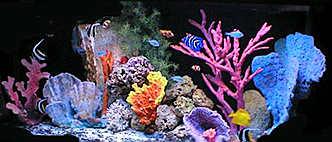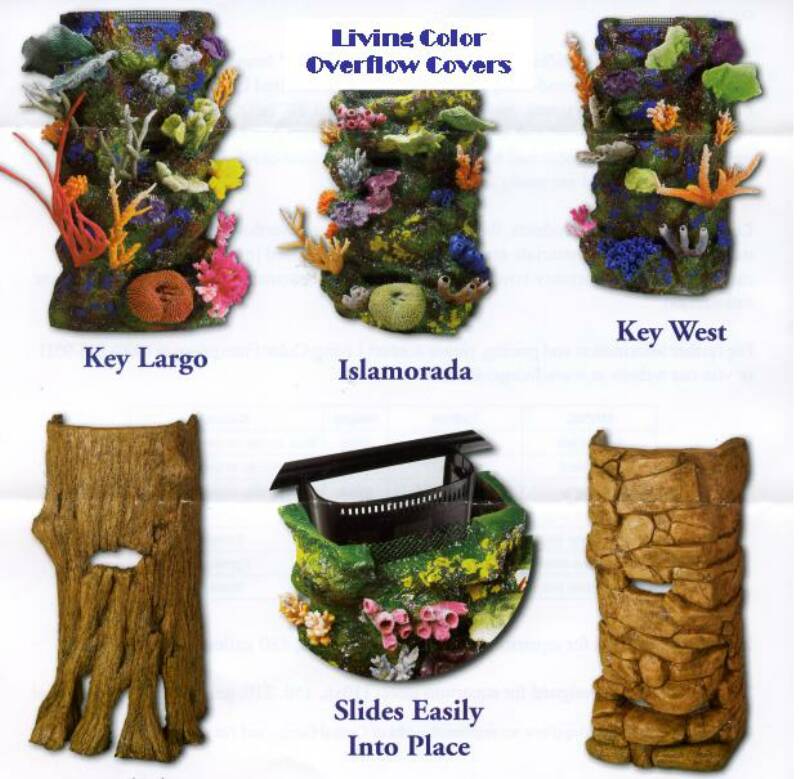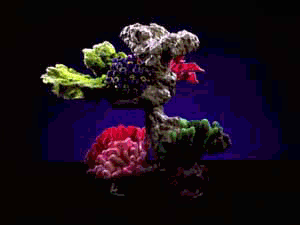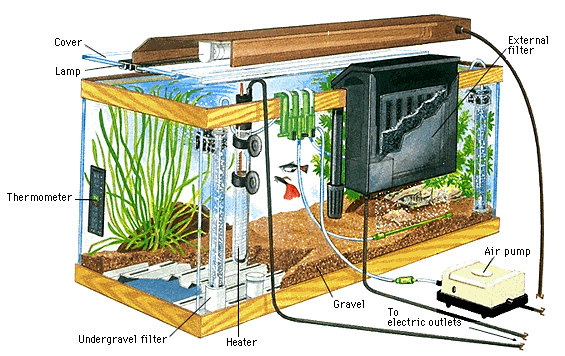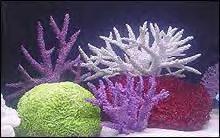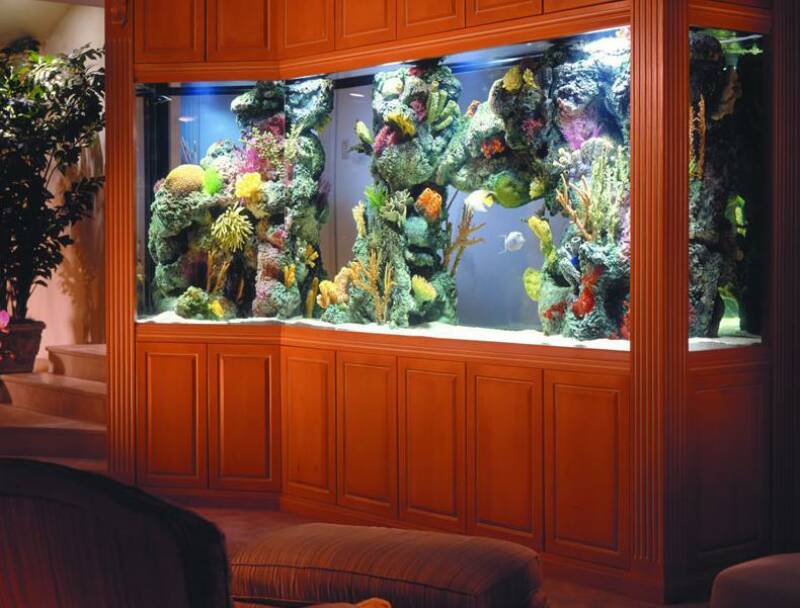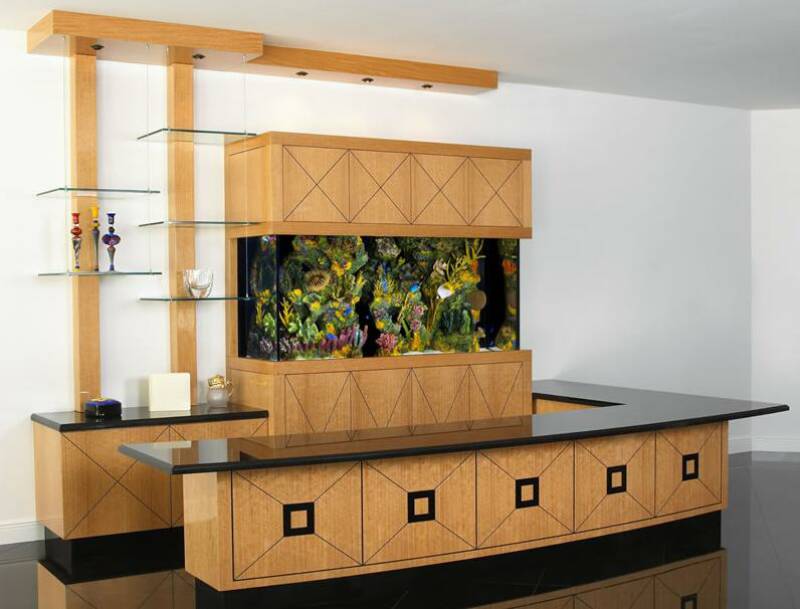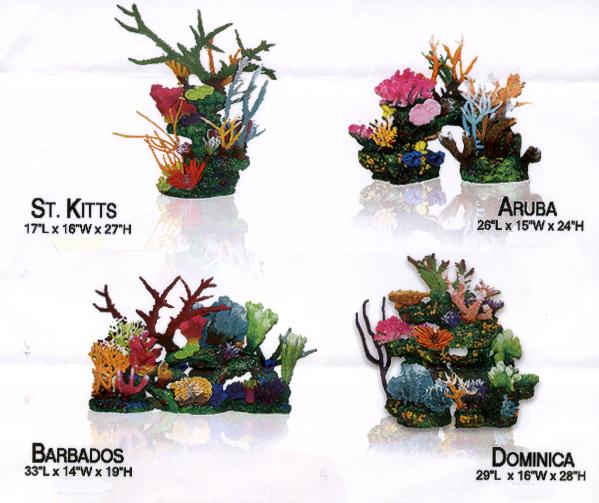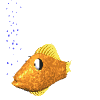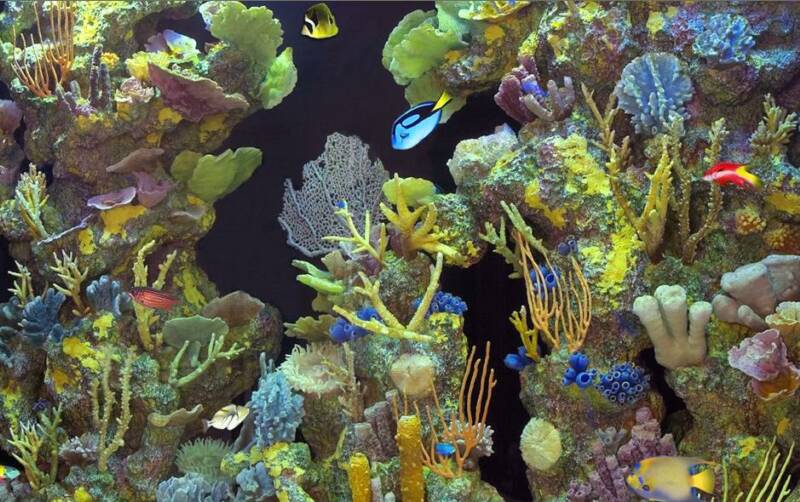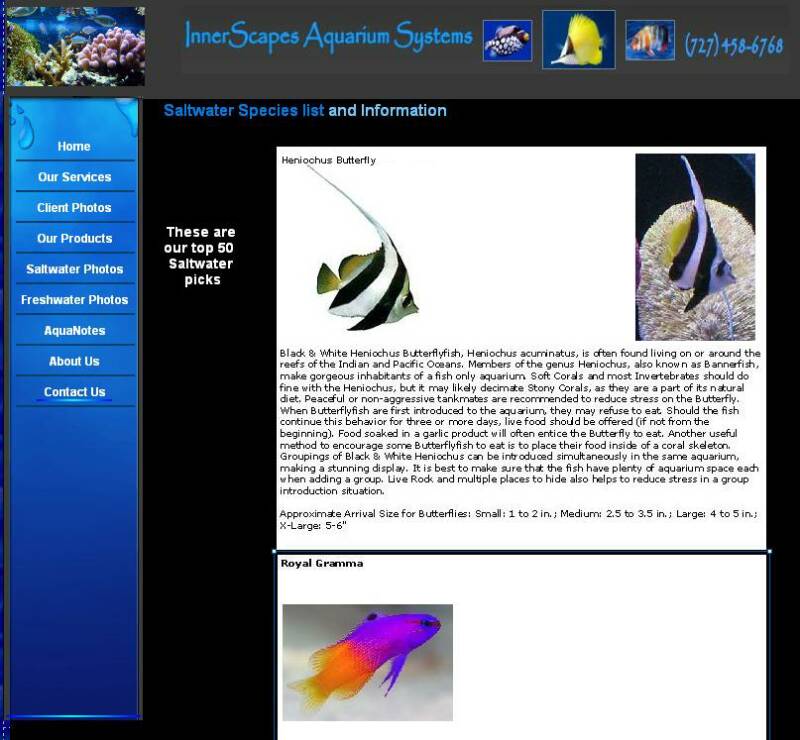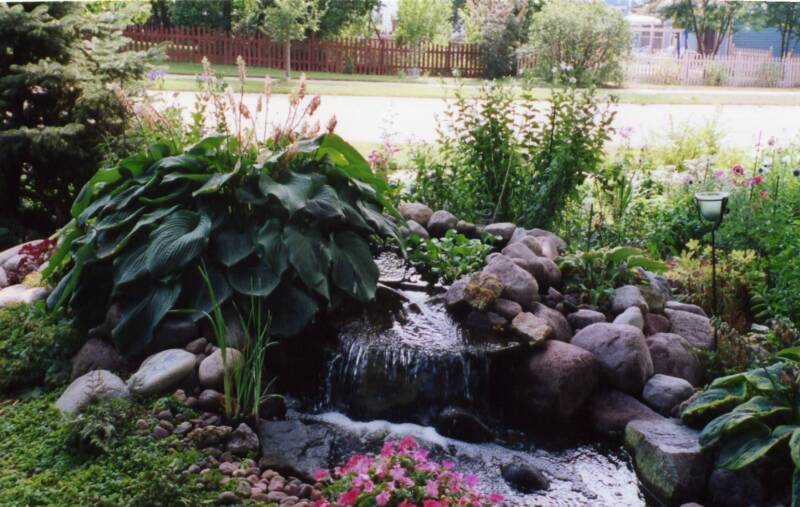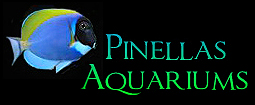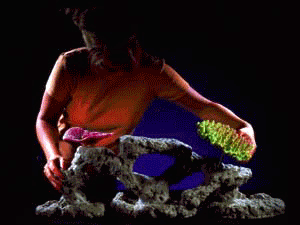"AquaNotes"
Feeding your Fish:
Remember : "Over-feeding" has nothing to do with your fish "over-eating".
Its all about not polluting their home!
* Please Feed the fish (not the tank)!
Following this advise will lead to a successful aquarium experience that
you can enjoy with far fewer problems and their eventual costs !
Food should very seldom reach the bottom before your fish get it!
You should strive to never see suspended, settled or floating food particles after 5 minutes!
And - Never allow food to be left on the tank bottom!
If you make a mistake and over feed any type of fish food, Please get out your net...
and go to work eliminating as much as possible!
(Excess food is often the primary cause of undesirable algae outbreaks and also a "trigger"
for many fish deaths related to poor water quality).
Just 5 minutes out of your day !
Some situations require daily or twice daily feedings. Others will require only feeding every three days or so. Consult your professional regarding your specific tank community. In all cases, each feeding will only require 5 minutes of your time.
Please be willing to invest this small amount of time at each feeding to observe what is happening. Do not feed and walk away.
You will save yourself many headaches and considerable money!
You will get to know your fishes habits and what foods they like.
And ...you will become better at NOT overdoing it.
Stay around and enjoy observing them during feeding!
Not only are they more active during this time, but it is highly important that you see that there is no uneaten food left behind!
You will also be able to note any unusual behavior that might indicate an emerging problem.
Very occasionally food will land on the substrate. If it can be removed - it should be!
Please take notice and do your level best to rid the tank of this potential pollution!
Net it out or grab it out - just get it out! You may be preventing a chain reaction
which could lead to many fish losses!
Then, be certain to adjust future feedings to insure that this does not happen often!
We subscribe to the philosophy that small frequent feedings are best.
So, be careful..... And responsible! Your fishes lives depend on it!'
Note: There are some instances where special feeding is required by certain bottom dwelling inhabitants
and also special foods required for certain species. There is much more on this subject such as feeding techniques
and types of food that are specific to certain fish and invertebrates.
Your aquarium professional will have specific recommendations for these.
Diseases in Aquarium Fish
Most of us understand that problems may occur in keeping all tropical fishes.
(This is where Your aquarium professional comes in)
You should, however, become informed!
Fact is, most will not have to deal often with disease outbreaks and will enjoy few problems for extended periods of time.
Watch your fish closely. You may help to notice something before it gets out of hand!
Your basic knowledge of disease recognition and prevention is very helpful in assisting us in keeping your fish healthy.
______________
Fish Anatomy
Simplified disease Chart
Diseases in Tropical fish
First, Please consider a quarantine tank. It is a worthwhile investment. You can watch for problems in new arrivals and medicate if necessary.
Also, an ultraviolet sterilizer is highly recommended to prevent outbreaks of parasites.
Fish are most susceptible to disease while adjusting to captive life.
There are very many pathogens in all “living” waters beginning with an individuals capture to holding to shipping, then holding again at your local fish store and finally in your home system. Imagine the journey that aquarium specimens have endured.
Stress:
Stress is the common thread in most cases of disease in aquarium fish. Though fish can be predisposed by genetic factors, stress is usually what sparks disease. Stress releases adrenaline which increases the heart rate and respiration.
Stressed fish can die of exhaustion or become weakened whereby the immune system cannot fight off a disease.
Stressed fish will eventually become sickly and diseased.
If the stress is severe (as in the case of the child tapping on the glass or even sometimes during routine maintenance of the aquarium)
the fish can go into shock and die on the spot.
Now, reflect on these other stress factors:
Wrong temperature or sudden changes in temperature
Improper pH or sudden changes in pH
Children banging on tank, or sudden movements that scare the fish
Poor diet.
Overfeeding which creates poor water conditons
Aggressive tank mates
No hiding places for the fish to feel safe
Overcrowding of your tank
Wrong salinity or changes in salinity
Any amount of ammonia present
High nitrite and nitrate levels
Any major change in any water chemistry levels
Toxins, such as Chlorine and Chloramines, copper, iron, lead, zinc, (common in municipal water)
Antibacterial household sprays, Cleaning ammonia, nicotine, oil, paint fumes, insecticides, pet pesticides like contamination from flea collars and flea powder, detergents, colognes, lotions, etc. and on and on…..
Even trace amounts of these toxins can have accumulated effects on the fishes resistance to disease if not directly poisoning them!
You MUST rinse your hands of any foreign substances. You can use salt, baking soda, or lemon juice to scrub your hands and arms. Rinse, rinse, rinse!
Reducing stresses:
Use a good conditioner like Stress coat or Novaqua. These are aloe based conditioners which help neutralize chlorine and chloramines as well as detoxify some metals, and provide an extra slime coating for the fish.
Remember, these conditioners will cause proteins skimmers to become overactive. You must disconnect your skimmer when using these products.
Common diseases:
PARASITES
Signs of a parasite infestation are:
White or whitish spots that look like salt or fine sugar crystals.
Scratching. If a fish rubs against objects in the tank, he is probably trying to rub off parasites.
Copper is the treatment of choice, but care must be taken to avoid damage to the biological filter.
This is where a quarantine tank is very useful. Freshwater dips can be used. Also decrease the salinity to around 1.015 or so. Also, insure that your tank temperature is constant.
LYMPHOCYSTIS
LYMPHOCYSTIS is a virus that lives off of impurities in the water while attached to the fish.
It doesn’t live off the fish but may kill indirectly by interfering with, swimming ability, respiration or the fish’s inability to feed..
Eliminate impurities in the water through optimal filtration, UV sterilization, water changes, or diatom filtration.
Lymphocytes can only be killed in the aquarium purifying the aquarium water.
BACTERIAL INFECTIONS
Signs of a bacterial infection usually appear as whitish patches or coatings on the body, fins or eyes. Cloudy eyes are often a tip off.
Use antibiotics and medicated foods to treat bacterial infections along with frequent water changes.
There are many different types of bacteria and you may have to try several types of antibiotics to find one that works. (Water changes between treatments)
Internal bacteria infections are identified by a fish that struggles to stay “neutrally buoyant”. The swim bladder is often affected by internal bacterial infections. Carbon will remove medications from the water and must be removed during treatment.
FUNGUS
Fungus is white with a velvety appearance. It is most likely to be found on the mouth, eyes, or fins.
Treatment consists of water changes, medicated food, and antibiotics.
POPEYE
Popeye is caused by an infection behind the eye. Medicated food and good tank conditions may help.
SWIM BLADDER DISEASE
The swim bladder is the organ which allows a fish to stay in “neutral buoyancy” in the aquarium (not sinking or floating). The swim bladder may be damaged by bacteria, parasites, or injury. When the swim bladder fails the fish loses its ability to swim normally and may swim sideways or even upside down. Use water changes and medicated foods.
DROPSY
Dropsy refers to a bacterial disease that causes a fish to swell so that the scales stick outward.
Normally when the disease has progressed this far there is little hope for the fish.
Note; if it is ever necessary to “euthanize” a fish, the most humane way to do so is to place it (in water) into a freezer. It is thought that the body functions slowly wind down and the fish should not suffer.
(The above are some of the most common diseases that you might encounter)
It is imperative that you examine your fish on a daily basis for any signs of the above symptoms.
The best time to do this is at feeding time. As you become aware of each of your aquarium inhabitants individual habits you should be able to recognize the onset of many of these conditions.
Naturally, it is necessary that you let your aquarium professional know of any such symptoms as soon as possible.
More on "stress"
Stress is often mentioned with regards to tropical fish diseases.
Very many pathogens live in the wild and are present in all aquarium water. Fish naturally carry a variety of pathogenic bacteria, fungi, and parasites. Aquariums also harbor these organisms, which are especially prevalent in the gravel. Healthy fish with healthy immune system should be able to fight off these ever present disease organisms but fish that have been affected by stress conditions may fall victim.
Stressed fish are more susceptible to various diseases. Generally stress is caused by transportation, physical damage during netting and transportation, adaptation to life in captivity, sudden temperature changes and radical activity outside their aquarium environment.
* A special note on the ethics of fishkeeping
Some might question the ethics of keeping aquarium fish, considering that many tropical fish are lost in capture,
transportation, holding and ultimately in the care of us, the hobbyists.
Food for thought:
We must consider, and it is widely accepted, that the aquarium hobby has done an enormous amount to educate and create empathy towards our natural environment.
Challenging as it may be, your aquarium can bring you hours of enjoyment, peace and tranquillity. And while they are in your care, most of your aquarium specimens will be living happily has clams, so to speak.
Remember, Life in the sea is short and seldom easy. Relatively few individual organisms survive to become adults and most of them that do seldom live more than a year or two. An individual fish may be eaten by a predator, caught in a net and frozen for market, or carefully collected and maintained in an aquarium for a time.
Losses can always be expected, but limiting mistakes by continuing your education will help reduce problems.
We have cared for many aquarium specimens that have lived a number of years, some well over a decade.
A healthy aquarium system can easily support the average fish living multiple years.
Bottom-line:
If you are enjoying the fun of keeping aquarium fish (and you do so responsibly) ....... then .......
....... Embrace the challenges and enjoy!
Frequently Asked Questions
How often should our aquarium be serviced?
Your monthly fee is based on an average weekly, biweekly, or monthly services. These are average planned service calls. Generally, your service technician will arrive within the parameters of specified regularity. However, we are working hard to keep many customers aquariums in top condition and some systems require more or less attention at varying times. Aquariums are by nature problematic. (This is why you have contracted with a professional). Emergencies sometimes occur and require that we alter our schedules. We ask for your patience if (on occasion) your service times vary. Please feel free to call on us at any time to inquire about our schedules.
Note * Your service contract may include unlimited service calls regardless of the nature of those calls.
You can rest assured that when you have a problem, we will be there to correct it!
Why does algae grow in my aquarium?
Cleaning or rotation to clean decorations will be a regular aspect of your aquarium service.
Algae is a naturally occurring plant life which is present in varying forms and in all aquaria. Algae is not harmful, however it can become unsightly. A good growth of healthy algae provides an additional food source for your fish and assists in oxygenation.
Your InnerScapes technician will control growths of certain algaes in your aquarium. You can assist us by occasionally wiping some “early growth algae” from the Interior glass. Overnight algae “blooms” can sometimes occur. Algae is dependent upon food and light. Excess food and light can cause unusual algae blooms. Changes in water chemistry, temperature, etc. also support algaes growth. Sometimes, depending on these many variables, algae blooms require unscheduled visits. We are always on call to handle any problems.
Can "R/O" water help reduce algae problems?
The answer is a resounding YES! Algae and bacteria thrive on the total dissolved solids which are mostly removed in reverse osmosis filtration.
How much do I feed my fish?
Important! Small frequent feedings are best. Feed a small amount and when it is quickly consumed by your fish, leaving nothing to fall to the bottom of the aquarium then you may feed more. A variety of food is very important for the health and well-being of your aquarium inhabitants.
Overfeeding will pollute your system!
Why do my fish sometimes fight amongst themselves?
Fish have different personalities. Some are aggressive, others are passive.
Fish do eat other fish. If one specimen becomes weakened or is otherwise too timid, he will fall often prey to other fish. Even compatible species sometimes will kill one another. Sometimes death occurs as a result of stress from being chased by other fish or as a result of competition from other specimens. We will do our best to recommend compatible species, but in this field no rule is absolute.
Why do healthy fish becomes sick?
Even established aquariums with healthy communities can become diseased. Parasites and bacteria are always present in aquarium water. Stress due to temperature fluctuations and other factors such as minute contaminants, can cause outbreaks of disease.
Note: Your aquarium technician has extensive experience in the diagnosis and treatment of aquarium illnesses.
At the first sign of unusual appearance or behavior in your fish, call us immediately!
You may be given instructions to continue to observe them or we may wish to immediately come have a look.
(Most often, you will not be charged for additional service calls).
We are at your service 24 hours a day, 365 days a year!
If you have a question or suspect a problem, please give us a call. We may be able to solve the situation over the phone.
As always, we appreciate your business and encourage your questions.
E-mail us with your questions
Setting up an aquarium
Perhaps you are considering “going it alone”
in setting up a smaller aquarium system or perhaps
you are hauling out that old aquarium for another try.
The following tips will prove helpful.
Of course, your aquarium consultant stands ready
to help you if you feel the need.
Advice and education
It is important as you setup, maintain and enjoy your aquarium
that you have a source for information on this great hobby.
Ask your aquarium professional to supply you with the
information and product needed to keep your aquarium
at its best. Make sure that you ask questions and use this
person to educate yourself on fish keeping techniques.
It will also benefit you to purchase a reference book
about fish keeping. Ask your professional to suggest a book
that will help you get started right in the hobby.
Location
It is important to choose the proper place for your new aquarium carefully. The aquarium should be placed on an appropriate size aquarium stand or a sturdy surface that can easily support the weight of the full aquarium. Do not place the aquarium in direct sunlight. Direct and indirect sunlight will result in excess algae growth making your aquarium unsightly and will increase the aquariums maintenance.
Cleaning your aquarium
It is important to clean your new aquarium prior to setup. Simply wipe the inside and outside with a water-dampened paper towel. Make sure that no cleaners, detergents or chemicals of any type are ever used when you are cleaning your aquarium. Be careful when handling a wet aquarium.
Adding gravel and decorations
After your aquarium is in place and cleaned, it is time to add gravel and decorations. Gravel is necessary to anchor live or artificial plants and decorations in your aquarium. It also helps to create a natural environment for your tank inhabitants. It is recommended that you purchase pre-packed or bulk gravel at your local pet store. Add approximately 1.5 pounds of gravel per gallon of water or about 2 inches of gravel in depth to your aquarium. Most gravel contains a little dust or particles that can cloud the water in your new aquarium. We recommend that you rinse your gravel thoroughly prior to use. This can be accomplished by using a colander or spare clean bucket. After your gravel is in place it is time to add rock, driftwood, plants, and other decorations to your aquarium. It is important to clean items with fresh water prior to use.
By adding decorations to your aquarium you will create a fish friendly environment. Use rock and driftwood to create tunnels and hiding places for your fish. You may also want to add artificial plants to the aquarium at this time. If you intend to use live plants it is recommended that you wait roughly one month after your aquarium is running and stocked. This will allow your aquarium to cycle properly.
Adding water
After your aquarium is decorated it is time to add water. Room temperature water should be used. Place a large bowl near the bottom of the aquarium. Begin to fill the aquarium by simply pouring the water into the bowl that has been placed in the aquarium. The bowl will diffract the stream of water decreasing the turbulence and allowing the majority of gravel and decorations to stay in place.
Once the aquarium is filled, the water should be treated to remove chlorine and/or chloramines. Ask your professional what product they recommend for the water in your area.
Filters
There are many filter options available to you through your local aquarium professional. These options include basic filters such as undergravel and sponge filters to power filters and sump filtration units. Each of these filters was designed for certain applications and/or environmental considerations. Your dealer will be able to recommend the type of filter that will best meet your needs. Make sure that you read and follow the directions provided by the manufacturer of whatever filter you decide to purchase.
Heaters
A heater is recommended for most tropical fish. Fluctuating temperatures may cause health issues in your aquatic environment. The majority of tropical fish live well in a temperature ranges between 74 and 80 degrees Fahrenheit. Ask your advisor for the specific temperature requirements for the fish you have selected. They should also be able to recommend a brand and size heater for your aquarium. A good rule of thumb would be to purchase a heater that has about 5 watts per every gallon of aquarium water. To help regulate the temperature you should purchase a thermometer. It should be placed opposite the heater. This will give you a good indication of water temperature in your aquarium and you can adjust accordingly.
Lighting
A fluorescent full hood is recommended to provide the necessary light for your fish and plants. It will also help reduce evaporation and will keep your fish from jumping out of the aquarium. Fluorescent light provides a natural, full-spectrum environment. Fluorescent lighting is also more energy efficient than incandescent hoods and the bulbs will last longer. An automatic timer is recommended to turn the lights on and off. Too much light may cause unwanted algae growth.
Adding fish
Once your aquarium is ready to handle the first arrivals (usually in a few days) it is time to add fish. Prior to heading to the pet store double check your water temperature and make sure your filter is running correctly. Make sure you choose appropriate fish for your aquarium. Smaller aquariums may not be suitable to house certain fish that may eventually outgrow their surroundings. When you return home with your fish make sure to acclimate them slowly. Begin by floating the closed fish bag in the aquarium for 5 to 10 minutes allowing the temperature in the bag to match the temperature in the aquarium. Next open the bag and roll down the top of the bag three or four times. This will create air pockets or a float ring that will allow the bag to freely float in the aquarium. Add a small amount of aquarium water to the open bag and allow the bag to continue to float. Repeat adding small amounts of aquarium water every few minutes for a total of 20 minutes. This will allow your fish to acclimate to the Ph and over-all water chemistry in your aquarium. Next gently pour your fish from the bag into a net discarding the water in the bag. Release your fish from the net into the aquarium.
Water testing
It is important to test your aquarium water to monitor ammonia, nitrite and Ph levels. Ask your professional for a complete water testing kit.
Feeding your fish
Ask your consultant for help in selecting the right type of fish food for the species of fish that you will be keeping. It is important that you offer your fish a variety of foods. Feed your fish small amounts of food multiple times a day. Watch your fish eat. This way you will be able to monitor and adjust the amount of food you are giving your fish. It is important not to overfeed your fish. Excess food in the aquarium water will lead to poor water quality, which can cause health issues for the inhabitants.
Enjoy
Keeping fish can be educational for children as well as a relaxing hobby for all ages.
*** Important Safety Information! ***
Handle with care!
Your aquarium must be handled with care to avoid personal injury or damage to the aquarium.
Lifting and carrying an aquarium
Always lift or carry an aquarium by supporting it from the bottom.
Never lift or attempt to move an aquarium that is not completely empty.
Never lift an aquarium with wet hands. It could slip out of your hands and break or cause injury.
Filling an aquarium
When you fill your aquarium use room temperature water. If you fill with cool water, condensation may appear on the outside of the glass. This condensation will eventually puddle, making the aquarium appear to have leaked water but is only coming from the outside of the aquarium. If condensation occurs, simply wipe the glass dry. Condensation does not occur when the water reaches room temperature.
Where to place your aquarium
For the best results, use an approved aquarium stand which was designed to support the weight of your aquarium. The filled weight of an aquarium is approximately 10 to 12 pounds per gallon. For example, a 50 gallon aquarium full weighs over 500 pounds. Never set up your aquarium on your shelving, book cases, dressers, television sets, tables, carts, or any place that will not support the weight of a full aquarium. This could cause the aquarium to leak, crack or even fall over if a top heavy situation is created.
NOTE:
Do not allow small children to touch, climb on or play with the aquarium or its stand. Aquarium stands that are less than 12" wide (front to back) should be fastened or tethered to the wall to prevent a top heavy, unstable condition should a child attempt to climb or pull on the stand.
Basic Aquarium System
Common mistakes made by aquarists Avoid mistakes - Educate yourself:
Impatience
It is very necessary to go slow when starting up any aquarium system.
Too often impatient hobbyists who have made the mistake of heavily stocking a tank within the first few weeks of the initial setup. No aquarium system is considered “seasoned” until it has been operating for at least a few months.
Many systems don’t achieve maximum condition for upwards of a year or more. That is when they would be considered to be capable of the greatest “holding capacity”
If you "overload" a tank with too much livestock or live rock all at once you may be asking for “new tank syndrome” whereby you have triggered an ammonia spike and will likely kill all your fish.
Inadequate Filtration
You can not “over filter” your tank! Plan according to your expected “bio-load”.
Err on the side of caution when choosing equipment.
Improper medications
You MUST first know what you are treating! Some diseases look very much alike. Do your homework. Research. Read.
Most importantly, medication should be done in a separate treatment tank, as most medications will have an adverse affect all the “good” bacteria that you have been waiting propagate and become established in the filter system.
Livestock Incompatibility
Think of what is happening on the reef in the open sea. It is a “fish eat fish” world. Now, overcrowd your “miniature reef” and see what happens.
Even known compatible species can become agitated with one another and a fight will ensue. Or maybe one inhabitant just decides to make another his dinner. It happens! So do your homework and never overcrowd!
Stress related disease can occur when one or more fish are simply uncomfortable with their tankmates. Do your best to learn which fish are happiest
together and then hope for the best.
Purchasing Fish in Poor Health
Always try to observe a fish at your local pet store for at least a few days and make sure that it is readily accepting food before you buy.
If they don’t eat in the store, don’t expect them to do well.
If a fish has any blemishes or odd looking fins or cloudy eyes don’t buy them.
Forgetting Routine Tank Maintenance Tasks
Properly maintained tanks experience far fewer problems; So, follow a regular maintenance routine.
Contact us ! We will be happy to help in any way we can!
Marine fish compatibility Chart
Suggestion: Right click on the chart then "save picture as" then save.
Freshwater fish compatibility Chart
Suggestion: Right click on the chart then "save picture as" then save.
Planning for a new aquarium ?
Educate yourself.
Ask us.
There are many experts out there. Follow the advice of ones you trust. We want you to be successful.
We will do our utmost to help you be a successful aquarium owner!
Do it right the first time.
Make sure you have good quality equipment. Spend a little extra time planning and you will be rewarded with many years of relaxing pleasure.
Aquarium Size
Purchase the largest aquarium you have space for and can afford. The larger the aquarium, the easier it will be to establish and maintain a healthy tank.
Location
Display the fish aquarium away from direct sunlight. Ensure that the stand selected can support the aquarium weight when it is filled with water.
A gallon of water weighs 8.34 pounds. Added to gravel and tank weight – figure 10 lbs. per gal.
Fish Tank Cover and Light
The cover keeps your fish in while stopping unwanted foreign matter and airborne pollutants out.
Light is very important to the aquarium. It sustains life by supporting photosynthesis, helps fish see and find food,
and can help fish find partners for spawning or spot predators that are close by.
Light also regulates the circadian rhythm, the day-night cycle that is regulated by an animal's
inner biological clock. Therefore, light cycles help a fish decide when it is time to eat or rest or when to breed.
Be patient.
You can not have a seasoned aquarium over night. By that we mean a new tank cannot support a lot of animals all at once. Generally, most marine systems are seasoned pretty well within a few months, but it will continue to mature for many years.
We also have methods to help you speed things up. Just don't buy too many fish too soon!
... Have fun!
The Nitrogen cycle
.
Also known as the "break in period" of new systems
The nitrogen cycle of an aquarium involves nitrifying bacteria, each with their own job to do. Each new bacteria in this cycle consumes the previous one, and in turn gives birth to the next bacteria.
The three components involved are ammonia (NH³), nitrite (NO²) and nitrate (NO³).
In general the nitrogen cycling process usually takes about 30 days, but there is no exact time frame for this process to complete its task as each aquarium is different. Factors such as how many fish, other livestock, and organic matter is present in the tank vary the cycling time. Testing your aquarium water during cycling is very important, as this will tell you what phase the aquarium is in at any given time throughout the process.
The 3 Components & Phases of "Nitrification"
Phase 1 - Ammonia
The first component needed in the cycle is ammonia. It is only during the cycling process that ammonia readings should be present in an aquarium.
Once ammonia begins to accumulate in the aquarium, the process begins. So where do you get the ammonia from? It is produced by such things as fish and other livestock waste, excess food and decaying organic matter from both animals and plants. Putting live animals into a tank for the purpose of cycling is difficult because they are exposed to highly toxic levels of ammonia and nitrite during the process. However, without ammonia present the cycle cannot begin, and if ammonia is removed, or the supply is disrupted during cycling, the process stops. If you think that adding an ammonia destroyer or doing a water change will bring it down, this will be only a temporary fix as the cycle must still take place! You are only delaying the cycling process. You can use hardy, ammonia tolerant fish to cycle and aquarium or live sand or live rock or all of the above.
Regardless of the method of cycling – the process takes time!
Phase 2 - Nitrite (NO²)
1 to 3 weeks into the cycle, the nitrifying bacteria (nitrosomonas) that convert ammonia into nitrite, should begin to appear and build. Just like ammonia, nitrite can be toxic and harmful to marine animals even at lower levels, and without nitrite present the cycling process cannot complete itself. Nitrite will continue to rise to a high level of about 15 ppm (that’s parts per million), the most critical stage, and at about week 4 or 5 the level should begin to fall off, although it's quite possible to run even longer. Most likely the nitrite reading will peak and fall off to less than 2 or 3 ppm by week 4, and shortly thereafter to zero. If it does not, don't worry, it should drop sometime within the next week or 2.
Phase 3 - Nitrate (NO³)
Now that the ammonia has given birth to nitrite, the nitrite in turn give birth to the third and final nitrifying bacteria (nitrobacters.)
These bacteria require oxygen and food (an ammonia source) to survive. The waste from nitrobacteria are shown in the form of nitrate with a test kit. When nitrate readings begin to increase, you can tell that these beneficial nitrifying bacteria are starting to establish themselves, which is what you have painstakingly been going through the cycling process to achieve.
Next:
Now that your new saltwater aquarium has reached the end of the nitrogen cycling process and completed its task of established the beginning of your tank's biological filter base, what do you do next?
Be Patient, and Move Slowly!
The stronger the bacteria become in numbers, the better they are able to absorb the "bio-load" placed on the aquarium. However, when the bio-load "exceeds" the nitrifying bacteria population established, ammonia will begin to show up in the aquarium again, and if the load is extremely heavy the reappearance of nitrite is most likely as well.
So ...... add fish slowly over the weeks and months to come!
NOTE:
Ammonia and nitrite "spikes" can also occur as a result of overfeeding (too much uneaten food in the system). Another common cause of these toxic spikes is often traced to a dead fish that has not been removed from your aquarium. So make it a habit of counting and examining all of your tanks inhabitants regularly. If you don't see an individual for more than a few days - You MUST do your best to locate and remove any that have expired!
Reverse Osmosis :
Enormously valuable for protecting your fish (and your family). Todays municipal water systems are not removing the traces of TDS (total dissolved solids) which help to pollute and sickin our fish. Allowable percentages of phosphates and organics are principally responsible for unwanted algae growths. Particularly helpful in reducing outbreaks of CynoBacteria.
A water purification device that forces feed water under pressure through a semi permeable membrane, allowing highly purified water with reduced solute content to pass out as the product - filtering out salts or total dissolved solids (TDS).
This when two channels of water are separated by a semi permeable membrane.
Water will flow from the side of Low solute concentration to the side of higher solute concentration.
If there are solute molecules only on one side of the system the pressure that stops the flow is called osmotic pressure. The solute molecules generate osmotic pressure on all the solution boundaries including the membrane, but when water flows between the two sides, it is the pressure on the
moving free surface of the solution which is pushing it upward and is responsible for water pumping from the other side.
Wow, that’s a mouthful!
Why don’t we just say that, "When polluted water reaches the membrane the majority of the water passes by, while some very highly filtered water gets through.”
Now, that was easier!
Needles to say, "R/O is the best way to go!
A typical 5 stage R/O systems Features
1st stage: 5 Micron Spun Fiber Pre-filter
2nd stage: Granular Activated Carbon filter
3rd stage: 1 Micron Spun Fiber Pre-filter
4th stage: RO Membrane
5th stage: Post Activated Carbon filter
Check Valve
Flow Restrictor
Storage Tank (3.2 G)
Booster Pump
Accessories Kit (Faucet, Wrench,
Water adapter & Ball valve)
Dimensions: 43 x 22 x 51 cm
Weight: 15 Kgs
We proudly offer Living Color Cabinetry and one of a kind Artificial coral reefs !
Why Choose Living Color Custom Cabinetry and corals?
Just look at the craftsmanship!
Living Color has one of the largest fabricated coral selections in the industry.
Their unique fabrication process assures the most natural looking, durable and non-toxic synthetic corals.
This variety of corals combine with various bases to create endless possibilities ...
... and reefs that are limited only
by your imagination !
Or you can build your own using the plug and play collection
The "Plug and play" Collection
Whether you're looking for an aquarium, fabricated coral or custom cabinetry
We can provide you with all the qualities of a masterpiece of timeless beauty!
Finished overflow Covers-
$300
and up
Basic aquarium set up
Note:
This one piece of info. may be the most important
thing to contribute to your success in fish keeping!
Another important tip :
Allowing a dead fish to decay in your tank is never a good idea. Inventory your fish each day and make sure you are not missing any. You are risking avoidable problems like ammonia spikes by not taking this simple precaution.
Please remember
No rule of thumb is constant in fish compatibility.
Individual fishes have unique personalities and exhibit very individual behavior.
Some fish become highly territorial, so your angel might still bully your anthias, etc.
On the reef it is survival of the fittest.
You must keep in mind that sometimes...
fish eat fish !
Examine your fish daily at feeding time.
Study :
Futher study :
Basic Water Chemistry
pH
pH is the measure of acidity of water. A pH reading of 7.0 is neutral. A pH higher than 7.0 is alkaline, and a pH lower than 7.0 is acidic. Maintaining the aquarium at the proper pH ensures optimal water quality. pH is easily measured with a pH test kit.
What is the right pH level for my fish?
Most freshwater aquarium fish will live in a pH range from 6.5 to 8.2. A pH of 7.0 is ideal when keeping a community aquarium containing a variety of tropical fish. Goldfish should be kept in their own aquarium and prefer a pH of 7.5. Many Amazonian fish, like angelfish and neon tetras, prefer a pH of 6.5 to 6.8. Mollies and swordtails thrive at pH 7.2 to 7.5. Some fish, such as African cichlids prefer water with high pH around 8.2.
How do I adjust the pH?
To raise or lower the pH of a freshwater aquarium, use Aquarium Pharmaceuticals pH UP or pH Down, following the directions on the container. Aquarium Pharmaceuticals Proper pH 6.5, 7.0, and 7.5 powders automatically adjust pH to the preset level.
What factors affect the ph in my aquarium?
The mineral content of the water in the aquarium greatly affects the pH. Water with a low carbonate hardness (KH) will tend to be acidic. Water with a high carbonate hardness (KH) will tend to have a high pH and be difficult to adjust. Read the FAQs about Water Hardness to understand the relationship between water hardness and pH.
What is ammonia?
Tropical fish continually release ammonia (NH3) directly into the aquarium through their gills, urine, and solid waste. Uneaten food and other decaying organic matter also add ammonia to the water. High levels of ammonia quickly lead to fish death. Even trace amounts stress fish, suppressing their immune system and thereby increasing the likelihood of disease outbreaks and subsequent fish loss. Ammonia is easily measured with an ammonia test kit.
What causes an ammonia problem?
A natural mechanism exists that controls ammonia in the aquarium - the biological filter. It is made up of nitrifying bacteria, which live in the gravel bed. However, as with any natural process, imbalances can occur. A newly set-up aquarium will not immediately have the right balance of bacteria and ammonia will build up. Over feeding and keeping too many fish in the aquarium will also cause an ammonia problem. Testing for the presence of toxic ammonia is essential, so that once detected, steps can be taken to remove it.
How do I prevent an ammonia problem?
In a new freshwater aquarium, the ammonia level may surge to 6 ppm (mg/L) or more, and then fall rapidly as the biological filter becomes established. The ammonia will be converted to nitrite (also toxic), then to nitrate. This process may take several weeks. In an established aquarium, the ammonia level should always remain at 0 ppm (mg/L). The presence of ammonia indicates possible over-feeding, too many fish, or inadequate biological filtration.
I have an ammonia problem. What should I do?
Overfeeding is a common cause of ammonia build-up. Make sure that all food is eaten within a few minutes. Sinking pellets and wafers should be completely eaten in 30 minutes. Uneaten food decomposes, adding ammonia to the water. To detoxify ammonia, use Aquarium Pharmaceuticals AMMO-LOCK to instantly lock up ammonia. AMMO-LOCK does not remove ammonia, it simply converts toxic ammonia to a non-toxic form. Ammonia test kits will still test positive for ammonia, even though it is non-toxic. The biological filter will then consume the non-toxic ammonia, converting it to nitrite (Nitrite is another toxic waste material which must be tested separately) and then to nitrate. If the gravel bed is dirty from accumulated waste and uneaten food, use a gravel siphon to remove the debris. Changing 25% of the aquarium water will reduce the ammonia level. In an emergency, a daily water change may be required over several days. Filter aquarium water with Aquarium Pharmaceuticals AMMO-CARB® or AMMO-CHIPS® to remove ammonia and improve water quality.
What is nitrate?
Nitrate (NO3-) is produced in the aquarium by the biological filter. Beneficial bacteria in the biological filter convert toxic ammonia and nitrite into nitrate. A high nitrate level indicates a build-up of fish waste and organic compounds, resulting in poor water quality and contributing to the likelihood of fish disease. In the opinion of many aquarists, maintaining a low nitrate level improves the health of fish and invertebrates.
What does nitrate come from?
Nitrite (NO3-) is produced in the aquarium by the biological filter. Beneficial bacteria in the biological filter convert toxic ammonia and nitrite into nitrate. Some tap water sources also contain nitrate. Nitrate is not considered toxic to freshwater tropical fish. Some fish breeders and collectors of sensitive species, however, are concerned with nitrate build-up.
What is a good nitrate level?
The level of nitrate acceptable to fish and invertebrates is a subject of much debate. All agree that "lower is better". A nitrate level of 40 ppm (mg/L) or less is recommended for freshwater aquariums. Many marine aquarists prefer to keep nitrate levels as low as possible, especially when keeping invertebrates.
How do I reduce my nitrate level?
In a freshwater aquarium use Aquarium Pharmaceuticals Nitra-ZorbT. Nitra-Zorb is a rechargeable filtration material that removes nitrate from freshwater. Making partial water changes can also help reduce the nitrate level, especially if the initial nitrate level is very high. However, because many tap water supplies contain nitrate, it can be difficult to lower nitrate levels by this method. Aquarium Pharmaceuticals Tap Water Filter will remove all pollutants, including nitrate, from tap water, making water changes effective.
In saltwater, partial water changes are the easiest way to lower nitrate. Because many water supplies contain nitrate, it can be difficult to lower nitrate levels by this method using ordinary tap water. Aquarium Pharmaceuticals Tap Water Filter will remove pollutants, including nitrate, from the tap water, making water changes effective.
What is nitrite?
Nitrite (NO2-) is produced in the aquarium by the biological filter. Beneficial bacteria in the biological filter convert toxic ammonia into nitrite (also toxic). The biological filter then converts nitrite into nitrate (NO3-). Testing for the presence of toxic nitrite is essential, so that once detected, steps can be taken to remove it. Otherwise, nitrite in the aquarium will prevent fish from carrying on normal respiration. High levels of nitrite quickly lead to fish death. Even trace amounts of nitrite stress fish, suppressing their immune system and, thereby, increase the likelihood of disease and subsequent fish loss.
What causes a nitrite problem?
In a new freshwater aquarium, the nitrite level may surge to 10 ppm (mg/L) or more, and then fall rapidly as the biological filter becomes established. The nitrite will be converted to nitrate. This process may take several weeks. In an established aquarium, the nitrite level should always remain at 0 ppm (mg/L). The presence of nitrite indicates possible over-feeding, too many fish, or inadequate biological filtration
What is phosphate?
Phosphorous is an essential element for plants and animals. Phosphorus, measured as phosphate (PO43-), enters the aquarium from fish and invertebrate waste and decaying organic matter, such as dead algae and uneaten fish food. Water treatment facilities may add phosphate to tap water to prevent pipe corrosion and reduce concentrations of heavy metals in drinking water.
Why test for phosphate?
While phosphate is required by fish and plants, too much phosphate can lead to cloudy water conditions. In saltwater aquariums, phosphate precipitates dissolved calcium (Ca2+) and magnesium (Mg2+) ions, inhibiting the growth of hard corals and other reef-building organisms.
What level of phosphate is safe?
While phosphate is not harmful to fish, the phosphate level should be zero in saltwater aquariums and freshwater aquariums, including those containing live plants. The phosphate level in a new aquarium will depend on the purity of the water used to fill the aquarium. Phosphate level in tap water can vary daily depending on the treatment process used. Phosphate tends to accumulate in established aquariums.
I have a high phosphate level. What should I do?
In a freshwater or saltwater aquarium use Aquarium Pharmaceuticals Phos-ZorbT. Phos-Zorb is a filtration material that removes phosphate. Making partial water changes can also help reduce the nitrate level, especially if the initial phosphate level is very high. However, because many tap water supplies contain phosphate, it can be difficult to lower phosphate levels by this method. Aquarium Pharmaceuticals Tap Water Filter will remove pollutants, including phosphate, from tap water, making water changes effective.
What is "Water Hardness"?
General Hardness or GH is the measure of calcium (Ca++) and magnesium ions (Mg++) dissolved in water. General Hardness is measured with the GH Test Kit. Carbonate Hardness, also known as KH, refers to the concentration of bicarbonate (HCO3-) and carbonate (CO3--) dissolved in water. Carbonate Hardness is measured with the KH Test Kit.
Calcium and magnesium carry a positive charge and form "ion pairs" with negatively charged ions like bicarbonate, forming calcium bicarbonate and magnesium bicarbonate; Ca(HCO3)2 & Mg(HCO3)2.
Marine reef aquarists interested in measuring the calcium level in their aquariums should use a calcium test kit made specifically for this purpose. The KH Test Kit can be used to test the carbonate hardness in saltwater aquariums.
How do I test for water hardness?
GH and KH are easily measured with the GH & KH Test Kit. This kit measures GH and KH in German degrees (° dGH & ° dKH) and parts per million (ppm). Some aquarium literature refers to water hardness in degrees while others use ppm. Your aquarium water may have a high GH and KH, low GH and KH, or a situation where one type of hardness is high and the other low, i.e. low GH & high KH. If, for example, you have a water softener on your tap water supply the GH will be zero (or very low) while the KH, which is not removed by a water softener, will remain high.
In marine aquariums the KH is supplied by the synthetic seawater mix used to make saltwater. The KH level will depend on the particular brand of salt.
What effect does water hardness have on the aquarium?
Water with a GH will contain a lot of calcium and/or magnesium. This is great if you are keeping African cichlids or other fish that like hard water. While excessive GH is not dangerous to tropical fish, many species come from water with a GH level of 35-ppm to 90-ppm (2-5° dGH). Most aquatic plants also prefer a GH level of 35-ppm to 90-ppm (2-5° dGH). Excess GH also contributes to white scale build-up on the aquarium lid and light fixture. As aquarium water evaporates calcium and magnesium (and other minerals) are left in the water causing GH to rise over time. Lowering GH (softening) has no effect on pH. Reducing the GH level does increase the effectiveness of Proper pH buffers (freshwater).
KH is important in relation to pH. KH, also known as alkalinity or buffering capacity helps stabilize the pH in the aquarium. Carbonate and bicarbonate ions give water its ability to resist increases or decreases in pH. Water with very low KH may experience wide fluctuations in pH because the buffering capacity is low. A high KH level indicates that the pH will be very stable. High KH is almost always associated with a high pH. This is not the case, however, when Proper pH buffers are added to freshwater aquariums. Proper pH products are true buffers. They will raise or lower pH to reach the pre-set pH level. Proper pH 7.0, for example, increases buffering capacity (KH) at pH 7.0. This means the buffering capacity is strong specifically at pH 7.0. The pH is "locked in" at 7.0.
KH can be adjusted in marine aquariums with Proper pH 8.2. Proper pH 8.2 increases KH by adding a blend of carbonate and bicarbonate buffers to the water. This adjusts the pH to a level of 8.2 to 8.4 depending on the existing buffer provided by the synthetic salt formula. Many marine aquarists try to maintain a KH level around 140 to 178-ppm (8 to 10 ° dKH).
How does KH affect pH adjustments?
Carbonate hardness directly affects the ease of making pH adjustments. In freshwater a high KH level makes lowering the pH very difficult. Each time a pH adjuster is added some of the KH is "neutralized". Each consecutive dose reduces the buffering capacity (KH) of the water. The pH will not go down, however, until the "breakpoint" is reached. When the breakpoint is reached the KH is sufficiently reduced to allow the pH to go down. This is why it may take several doses of aquarium pH adjusters to successfully lower the pH. Adjusting the pH is much easier after the KH has been reduced. Maintaining the pH once adjusted can be difficult with tap water having a high KH level. Every time tap water is added more KH is added to the aquarium. This shifts the water chemistry toward a higher pH level. Some aquarists use distilled water to replace evaporated water. Other kinds of bottled water like spring water are usually high in minerals and will increase water hardness. The Tap Water Filter will remove all minerals and pollutants from tap water, permitting easy adjustment of pH and water hardness.
The pH of some synthetic marine salts stabilize below or above the recommended 8.2 to 8.4 pH range. Even though the KH is acceptable, the pH may not be right for the aquarium. Proper pH 8.2 will adjust the pH to the desired pH range of 8.2 to 8.4.
Does evaporation increase water hardness?
Yes. When water evaporates, it leaves all the hardness minerals in the aquarium. When you add tap water back to the aquarium, it adds more hardness minerals, which remain as the water evaporates. Partial water changes help keep the water hardness from building up from evaporation. The best way to manage water hardness levels is the Tap Water Filter.
How do I reduce water hardness?
Reducing GH can be accomplished with the Water Softener Pillow. The Water Softener Pillow only removes GH and has no effect on KH. The easiest way to reduce GH and KH is with the Tap Water Filter. The Tap Water Filter will make deionized water with no GH or KH. You can than adjust the GH and KH with Electro-Right and pH Adjuster or use the deionized water to make water changes in your aquarium. Water changes with the Tap Water Filter will gradually reduce GH and KH through dilution. Adding deionized water to replace evaporated water prevents water hardness build-up.
ck here to add text.
Artificial "Eco" Corals
Artificial Corals by Living Color.
These Artificial Reefs are the finest quality available.
Beautiful coral replicas cast in molds made from real coral specimens in a large variety of colors !
Fish Species lists
with full descriptions :
Photography
 | ||||||
 | ||||||
 | ||||||
Finished Plug and Play reefs $500 - $ 1100
 | ||||||
Custom Reef sculptures can be designed to fit any size system, whether a living color cabinet or otherwise. Custom fit reefs for any tank size !
Suncoast / Pinellas Aquariums / InnerScapes Aquarium Systems Tel.727.556-0900
Aquarium Sales & Installations
Custom Aquarium Design
Professional Maintenance Services
Consultation
InnerScapes Aquariums - Since 1980
Aquatic beauty for your home or workplace
727-556-0900
